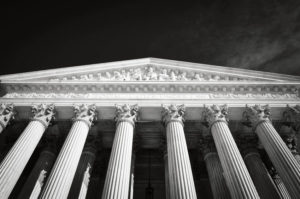SCOTUS Watch: Disenfranchising Voters in April, Going Public in May

Tony Evers, governor of Wisconsin, took the threats of COVID-19 seriously when he planned to delay the general election vote and extend the window for absentee ballots so voters could stay at home. However, Republicans in the state quickly challenged these measures, finding audience before the Supreme Court which, in a five-four decision, ruled against the protective measures. SCOTUS effectively forced Wisconsin voters to risk their lives so they could vote while raising serious concerns for future elections during the crisis.
The unauthored decision spanned only four pages and claimed to address only a narrow issue. Specifically, that the district court awarded more than was requested. Originally, the district court granted an extension to the absentee ballot that allowed voters to mail in the ballots after the election date, April 7, so long as they were received by April 13. According to SCOTUS, the lower court acted on its own accord and against precedent in granting this extension, which, it stated, “fundamentally alters the nature of the election.”
Indeed, it would have fundamentally altered the election by allowing people to vote.
SCOTUS assured that their decision “should not be viewed as expressing an opinion on the broader question of whether to hold the election, or whether other reforms or modifications in election procedures in light of COVID-19 are appropriate.” But Justice Ruth Bader Ginsburg, authoring a scathing six-page dissent, appropriately stated this decision “boggles the mind” and “will result in massive disenfranchisement” of voters. This decision forced voters to vote in person, risking exposure to COVID-19 and endangering the welfare of the public.
The impact of this decision cannot be understated. The precedent here is that any change in the election process is challengeable. Even if the changes are intended to protect the health and safety of voters. Already, Wisconsin has seven confirmed cases resulting from the in-person elections.
Despite Republican and conservative disenfranchisement efforts, Democrats thrived. Liberal challenger Jill Karofsky took the seat on the Wisconsin Supreme Court over Trump-backed incumbent Justice Daniel Kelly, and Democratic presidential nominee Joe Biden did well with blue-collar voters, garnering stronger numbers than usual for a Democrat in an open primary.
However, even with the heaviest turnout for a spring election since 2016 (approximately 34 percent), many Wisconsin voters went without a voice in the election because they didn’t receive the absentee ballot in time and couldn’t risk going to the election centers.
Many view these recent actions as Republicans shooting themselves in the foot. By challenging the governor’s attempts to ensure safety among voters by claiming voter fraud or trying to boost numbers, Republicans showcased nothing more than a clear attempt to silence voters. It didn’t work, and the nation saw their tactics front and center.
In fact, because Americans are isolated in their homes, they’re consuming more news than ever before. This may have served to encourage voters, said Barry Burden, director of the Elections Research Center at the University of Wisconsin-Madison. As such, staying informed is more important than ever.
Karofsky’s win gives further hope for voter rights in Wisconsin. The state is geared to remove more than 200,000 voters from its voter rolls. The purge began in a court order to force the Wisconsin Board of Elections to remove the voters after they failed to respond about a change in address. The Wisconsin Court of Appeals stayed the order, but the issue will be heard by the state supreme court, which had weighed heavily in Republicans’ favor with only two liberal justices. Now, Karofsky brings that number to three. The issue rages on, however, as Kelly seeks to stay on the case despite recusing himself before the elections. Karofsky will join the Supreme Court in July, but the case is expected to be heard earlier.
For those keeping a close eye on future US Supreme Court decisions, it was recently announced that due to the pandemic, SCOTUS will be hearing oral arguments via live audio feed over six days in May (May 4-6 and 11-13), and that these feeds will be open to the public. Cases involve important matters such as reservation rights, employment discrimination, health coverage of birth control, and President Trump’s financial records. Take some time in May to listen to one or all the arguments. Here are a few to keep an eye out for:
1. McGirt v. Oklahoma – This case asks whether federal law can circumvent the rights of a Native American reservation for some major crimes committed there by or against Native Americans.
2. Our Lady of Guadalupe v. Morrissey-Berry and James School v. Biel – These two cases focus on employment discrimination claims brought by teachers at Catholic schools.
3. Little Sisters of the Poor Saints. Peter and Paul Home v. Pennsylvania and Trump v. Pennsylvania – These cases challenge the expansion of the “conscience exemption” from the Affordable Care Act’s birth-control mandate, which allows people to opt-out of providing birth control for religious reasons.
4. Chiafalo v. Washington and Colorado Department of State v. Baca (Justice Sotomayor is recused) – These cases challenge the “faithless elector” laws, which require presidential electors to vote the way the state law directs, i.e., the statewide or district popular vote or a candidate the state pledged to vote.
5. Trump v. Vance – This case asks whether a Manhattan district attorney can obtain the president’s tax returns as part of a state grand-jury investigation
6. Trump v. Mazars and Trump v. Deutsche Bank – Similar to the above case, these cases ask whether congressional committees have the authority to issue subpoenas to the president’s accountant and creditors for the president and his business entities’ financial records.
